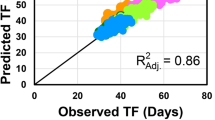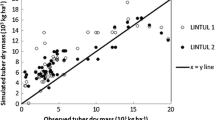Abstract
The improvement of quantitative traits in plant breeding will in general benefit from a better understanding of the genetic basis underlying their development. In this paper, a QTL mapping strategy is presented for modelling the development of phenotypic traits over time. Traditionally, crop growth models are used to study development. We propose an integration of crop growth models and QTL models within the framework of non-linear mixed models. We illustrate our approach with a QTL model for leaf senescence in a diploid potato cross. Assuming a logistic progression of senescence in time, two curve parameters are modelled, slope and inflection point, as a function of QTLs. The final QTL model for our example data contained four QTLs, of which two affected the position of the inflection point, one the senescence progression-rate, and a final one both inflection point and rate.




Similar content being viewed by others
References
Borrell AK, Hammer GL, Douglas ACL (2000) Does maintaining green leaf area in Sorghum improve yield under drought? I leaf growth and senescence. Crop Sci 40:1026–1037
Bradshaw HD, Stettler RF (1995) Molecular genetics of growth and development in Populus IV Mapping QTLs with large effects on growth, form, and phenology traits in a forest tree. Genetics 139:963–973
Celis-Gamboa C (2002) The life cycle of the potato (Solanum tuberosum L): from crop physiology to genetics. Ph.D. Thesis. Wageningen University, Wageningen
Celis-Gamboa C, Struik PC, Jacobsen E, Visser RGF (2003) Temporal dynamics of tuber formation and related processes in a crossing population of potato (Solanum tuberosum). Ann Appl Biol 143:175–186
Davidian M, Giltinan DM (2003) Nonlinear models for repeated measurement data: an overview and update. J Agric Biol Environ Stat 8:387–419
van Eeuwijk FA, Malosetti M, Yin X, Struik PA, Stam P (2005) Statistical models for genotype by environment data: from conventional ANOVA models to eco-physiological QTL models. Aust J Agric Res 56:883–894
Gepstein S, Sabehi G, Carp M-J, Hajouj T, Nesher MFO, Yariv I, Dor C, Bassani M (2003) Large-scale identification of leaf senescence-associated genes. Plant J 36:629–642
Grattapaglia D, Sederoff R (1994) Genetic linkage maps of Eucalyptus grandis and Eucalyptus urophylla using a pseudo-testcross: mapping strategy and RAPD markers. Genetics 137:1121–1137
Haley CS, Knott SA (1992) A simple regression method for mapping quantitative trait loci in line crosses using flanking markers. Heredity 69:315–324
Hartford A, Davidian M (2000) Consequences of misspecifying assumptions in nonlinear mixed effects models. Comput Stat Data Anal 34:139–164
Jansen RC (1992) A general mixture model for mapping quantitative trait loci by using molecular markers. Theor Appl Genet 85:252–260
Jansen RC (1993) Interval mapping of multiple quantitative trait loci. Genetics 135:205–211
Jansen RC, Stam P (1994) High resolution of quantitative traits into multiple loci via interval mapping. Genetics 136:1447–1455
Jiang CJ, Zeng ZB (1997) Mapping quantitative trait loci with dominant and missing markers in various crosses from two inbred lines. Genetica 101:47–58
Kao CH (2000) On the differences between maximum likelihood and regression interval mapping in the analysis of quantitative trait loci. Genetics 156:855–865
Lander ES, Botstein D (1989) Mapping Mendelian factors underlying quantitative traits using Rflp linkage maps. Genetics 121:185–199
Lindstrom MJ, Bates DM (1990) Nonlinear mixed effects models for repeated measures data. Biometrics 46:673–687
Littell RC, Milliken GA, Stroup WW, Wolfinger RR (1996) SAS system for mixed models. SAS Institute Inc, Cary
Lynch M, Walsh B (1998) Genetics and analysis of quantitative traits. Sinauer Associates, Sunderland
Ma C-X, Casella G, Wu R (2002) Functional mapping of quantitative trait loci underlying the character process: a theoretical framework. Genetics 161:1751–1762
Malosetti M, Voltas J, Romagosa I, Ullrich SE, van Eeuwijk FA (2004) Mixed models including environmental covariables for studying QTL by environment interaction. Euphytica 137:139–145
Martínez O, Curnow RN (1992) Estimating the locations and the sizes of the effects of quantitative trait loci using flanking markers. Theor Appl Genet 85:480–488
van Ooijen JW (2004) MapQTL® 5, software for the mapping of quantitative trait loci in experimental populations. Kyazma B.V., Wageningen, The Netherlands
Price AH, Tomos AD (1997) Genetic dissection of root growth in rice (Oriza sativa L) II: mapping quantitative trait loci using molecular markers. Theor Appl Genet 95:143–152
Reymond M, Muller B, Leonardi A, Charcosset A, Tardieu F (2003) Combining quantitative trait loci analysis and an ecophysiological model to analyze the genetic variability of the responses of maize leaf growth to temperature and water deficit. Plant Physiol 131:664–675
Rodriguez-Zas SL, Southney BR, Heyen DW, Lewin HA (2002) Detection of quantitative trait loci influencing dairy traits using a model for longitudinal data. J Dairy Sci 85:2681–2691
Schnute J (1981) A versatile growth model with statistically stable parameters. Can J Fish Aquat Sci 38:1128–1140
Smith AB, Cullis B, Appels R, Campbell AW, Cornish GB, Martin D, Allen HM (2001) The statistical analysis of quality traits in plant improvement programs with application to the mapping of milling yield in wheat. Aust J Agric Res 2:1207–1219
Tardieu F (2003) Virtual plants: modelling as a tool for the genomics of tolerance to water deficit. Trends Plant Sci 8:9–14
Thomas H, Howarth CJ (2000) Five ways to stay green. J Exp Bot 51:329–337
Verbeke G, Molenberghs G (2000) Linear mixed models for longitudinal data. Springer, Berlin Heidelberg New York
Verbyla A, Eckermann PJ, Thompson R, Cullis B (2003) The analysis of quantitative trait loci in multi-environment trials using a multiplicative mixed model. Aust J Agric Res 54:1395–1408
Verhaegen D, Plomion C, Gion J-M, Pointel M, Costa P, Kremer A (1997) Quantitative trait dissection analysis in Eucalyptus using RAPD markers: 1. Detection of QTL in interspecific hybrid progeny, stability of QTL expression across different ages. Theor Appl Genet 95:597–608
Vos P, Hogers R, Bleeker M (1995) AFLP: a new technique for DNA fingerprinting. Nucleic Acids Res 23:4407–4414
Wu W-R, Li W-M, Tang D-Z, Lu H-R, Worland AJ (1999) Time-related mapping of quantitative trait loci underlying tiller number in rice. Genetics 151:297–303
Wu R, Ma C-X, Chang M, Littell RC, Wu SS, Yin T, Wang M, Casella G (2002a) A logistic mixture model for characterizing genetics determinants causing differentiation in growth trajectories. Genet Res 79:235–245
Wu W, Zhou Y, Li W, Mao D, Chen Q (2002b) Mapping of quantitative trait loci based on growth models. Theor Appl Genet 105:1043–1049
Wu R, Ma C-X, Yang MC, Chang M, Littell RC, Santra U, Wu SS, Yin T, Huang M, Wang M, Casella G (2003a) Quantitative trait loci for growth trajectories in Populus. Genet Res 81:51–64
Wu R, Ma C-X, Zhao W, Casella G (2003b) Functional mapping for quantitative trait loci governing growth rates: a parametric model. Physiol Genomics 14:241–249
Yin X, Struik PC, van Eeuwijk FA, Stam P, Tang J (2005) QTL analysis and QTL-based prediction of flowering phenology in recombinant inbred lines of barley. J Exp Bot 56:967–976
Zeng ZB (1993) Theoretical basis for separation of multiple linked gene effects in mapping quantitative trait loci. Proc Natl Acad Sci USA 90: 10972–10976
Zeng ZB (1994) Precision mapping of quantitative trait loci. Genetics 136:1457–1468
Acknowledgments
We are grateful to Cajo ter Braak and H-P Piepho for their discussion and comments on the manuscript. We also thank the Editor and two anonymous reviewers whose comments helped to improve the final version of the manuscript.
Author information
Authors and Affiliations
Corresponding author
Additional information
Communicated by J. L. Jannink
Rights and permissions
About this article
Cite this article
Malosetti, M., Visser, R.G.F., Celis-Gamboa, C. et al. QTL methodology for response curves on the basis of non-linear mixed models, with an illustration to senescence in potato. Theor Appl Genet 113, 288–300 (2006). https://doi.org/10.1007/s00122-006-0294-2
Received:
Accepted:
Published:
Issue Date:
DOI: https://doi.org/10.1007/s00122-006-0294-2




